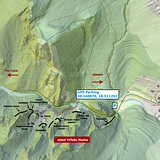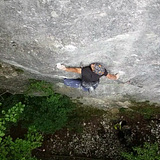The Manin Strait is less than a kilometer long and in some places only a few meters wide.
The strait attracts tourists and, despite increasing numbers of visitors, it retains a peaceful atmosphere. In the summer, especially, the gorge provides relief from exhausting heat, as does the view of the Manin Gorge from the cliffs below Veľký Manín.
The crags of Velký Manín (High Manin) include sectors that are relatively easily accessible, perhaps with the sole exception of the Pekelná and Posledná sectors. The approach to the crags is from a car park behind the strait. You need to walk back to the bridge on the left. Immediately beyond the bridge, there is a sector called Skala nad lúčkou (the Rock above the Meadow). Other sectors can be reached from the Meadow by a steep path to the right. The same path also leads to the interesting touristic sites: a viewpoint by the Spodná and Horná gotická stena sectors and to the cave under Černokňažnik.
The area is often sought after in the summer months as most sectors are shaded due to their orientation or foliage.
Climbers came to the Manin Strait in 1944; until then the place was only known to the locals and the tourists. The first climbers arrived hoping to train while discovering the rock labyrinth‘s climbing possibilities.
They discovered a crack in the cliff, which, since it was cloudy and dark, reminded them of a warlock‘s hat. Climbers J. Dostál and M. Peške returned to this crack on 18.3.1945 to attempt a first ascent in the surroundings of Manín. They called it Cesta stredom (the Route through the Middle) in Wthe sector Stena černokňažníkov (the Wall of the Warlocks). It took them several hours to climb the route.
Other first ascents followed on the walls and the cliffs Stráž, Stratené veže, Bosmany, etc.
During those years, the first ascent of Pekelná stena (Hell Wall) was a serious climb. It took the first climbers (Andrášik, Dostál, Horníček) almost twelve hours to reach the top of the nearly 70—meter high rock wall. Similarly, several first ascents on Stratené veže (the Lost Towers) were very daring feats at that time.
In the 1950s, climbing equipment was slowly changing, climbers replaced the simple plimsolls footwear with solid Vibrams shoes, and heavy hemp ropes with lighter synthetic ropes. However, slings and self—made pitons from construction iron remained the principal climbing equipment. Climbers continued to secure themselves with rope around their chests. These were among the reasons for why attempts at new first ascents ceased in the second half of the 1950s and 1960s; most of the ascents were a repeating of routes. Nevertheless, during those years, climbers made constant efforts at something new, but the walls were too challenging for the given equipment which resulted in projects remaining open.
The big turning point happened in the 1970s: a rediscovery of the first ascents in the Manin Strait began with a new younger generation joining the club. Countless new lines were achieved during this period alongside new equipment being adopted by the local climbers. Instead of the hard Vibram shoes they now used softer footwear such as kicks and slippers.
During this period, all routes were attempted from ground up. However, new protection aids such as nuts, stoppers, hexentrics and new shapes of pitons have already appeared. Nevertheless, as the new modern equipment was sparsely available, local climbers often passed climbing equipment imported from abroad to the local testing labs, striving to design materials and new shapes for the production of locally made protection aids. The new pitons and other equipment made it possible to attempt routes that were previously difficult to secure. In the late 1970s, a first climbing harness appeared among members of the club, and climbers used the model to sow their own harnesses accordingly. Whereas this was a significant advance, ascents continued being climbed from the ground up (often mainly technically because of the difficulty) and to the top of the rock wall. There was no abseiling, the descent was always around the rocks.
In the early 1980s, first RP ascents appeared as several local climbers introduced inspiring trends from abroad.Techniques from abroad not only gave impetus for RP ascents, but motivated the creation of routes „from the top“, by abseiling. This created a long—standing dilemma and became the source of a struggle between the older and younger generation in the Manin Strait: whether to climb new routes and lines purely in the traditional style from ground up, or to adopt trends from abroad and bolt new lines by abseiling from the top.The young climbers continued proving to the older generation that despite them bolting routes from the top, they were able to climb hard climbs in the style of first ascent from ground up (e.g. Lady Punk route on Slnečné skaly class 8, R. Hájek and Š. Kuchár). This quarrel finally ended with the opening of the classification and through climbing the route Vzdušný vlk (AirWolf) in RP style on sector Vlna in 1995. Note that until then, a closed classification only up to grade 6 was used in the strait and there were no routes of harder difficulty.
In the 1990s, new members created a number of new routes in the Manin Strait and its surroundings. Almost all of them were bolted from top down. The reason was the difficulty of the routes since increasingly harder routes were being attempted.
In recent years, young climbers have discovered and climbed old forgotten projects and challenges.


